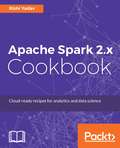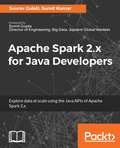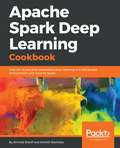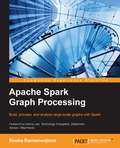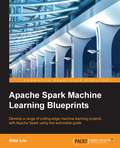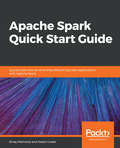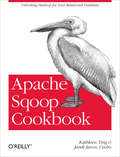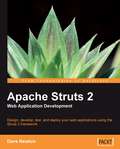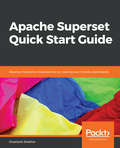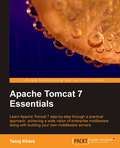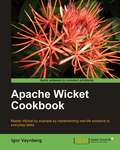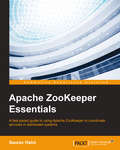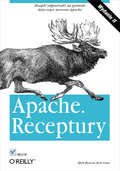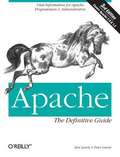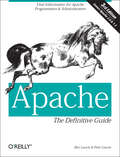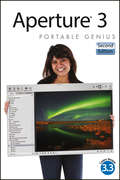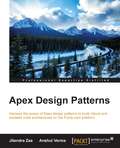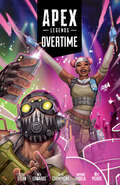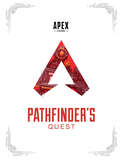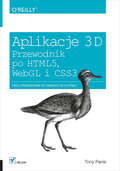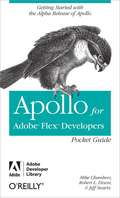- Table View
- List View
Apache Spark 2.x Cookbook
by Rishi YadavOver 70 recipes to help you use Apache Spark as your single big data computing platform and master its libraries About This Book • This book contains recipes on how to use Apache Spark as a unified compute engine • Cover how to connect various source systems to Apache Spark • Covers various parts of machine learning including supervised/unsupervised learning & recommendation engines Who This Book Is For This book is for data engineers, data scientists, and those who want to implement Spark for real-time data processing. Anyone who is using Spark (or is planning to) will benefit from this book. The book assumes you have a basic knowledge of Scala as a programming language. What You Will Learn • Install and configure Apache Spark with various cluster managers & on AWS • Set up a development environment for Apache Spark including Databricks Cloud notebook • Find out how to operate on data in Spark with schemas • Get to grips with real-time streaming analytics using Spark Streaming & Structured Streaming • Master supervised learning and unsupervised learning using MLlib • Build a recommendation engine using MLlib • Graph processing using GraphX and GraphFrames libraries • Develop a set of common applications or project types, and solutions that solve complex big data problems In Detail While Apache Spark 1.x gained a lot of traction and adoption in the early years, Spark 2.x delivers notable improvements in the areas of API, schema awareness, Performance, Structured Streaming, and simplifying building blocks to build better, faster, smarter, and more accessible big data applications. This book uncovers all these features in the form of structured recipes to analyze and mature large and complex sets of data. Starting with installing and configuring Apache Spark with various cluster managers, you will learn to set up development environments. Further on, you will be introduced to working with RDDs, DataFrames and Datasets to operate on schema aware data, and real-time streaming with various sources such as Twitter Stream and Apache Kafka. You will also work through recipes on machine learning, including supervised learning, unsupervised learning & recommendation engines in Spark. Last but not least, the final few chapters delve deeper into the concepts of graph processing using GraphX, securing your implementations, cluster optimization, and troubleshooting. Style and approach This book is packed with intuitive recipes supported with line-by-line explanations to help you understand Spark 2.x's real-time processing capabilities and deploy scalable big data solutions. This is a valuable resource for data scientists and those working on large-scale data projects.
Apache Spark 2.x for Java Developers
by Sourav Gulati Sumit KumarUnleash the data processing and analytics capability of Apache Spark with the language of choice: Java About This Book • Perform big data processing with Spark—without having to learn Scala! • Use the Spark Java API to implement efficient enterprise-grade applications for data processing and analytics • Go beyond mainstream data processing by adding querying capability, Machine Learning, and graph processing using Spark Who This Book Is For If you are a Java developer interested in learning to use the popular Apache Spark framework, this book is the resource you need to get started. Apache Spark developers who are looking to build enterprise-grade applications in Java will also find this book very useful. What You Will Learn • Process data using different file formats such as XML, JSON, CSV, and plain and delimited text, using the Spark core Library. • Perform analytics on data from various data sources such as Kafka, and Flume using Spark Streaming Library • Learn SQL schema creation and the analysis of structured data using various SQL functions including Windowing functions in the Spark SQL Library • Explore Spark Mlib APIs while implementing Machine Learning techniques to solve real-world problems • Get to know Spark GraphX so you understand various graph-based analytics that can be performed with Spark In Detail Apache Spark is the buzzword in the big data industry right now, especially with the increasing need for real-time streaming and data processing. While Spark is built on Scala, the Spark Java API exposes all the Spark features available in the Scala version for Java developers. This book will show you how you can implement various functionalities of the Apache Spark framework in Java, without stepping out of your comfort zone. The book starts with an introduction to the Apache Spark 2.x ecosystem, followed by explaining how to install and configure Spark, and refreshes the Java concepts that will be useful to you when consuming Apache Spark's APIs. You will explore RDD and its associated common Action and Transformation Java APIs, set up a production-like clustered environment, and work with Spark SQL. Moving on, you will perform near-real-time processing with Spark streaming, Machine Learning analytics with Spark MLlib, and graph processing with GraphX, all using various Java packages. By the end of the book, you will have a solid foundation in implementing components in the Spark framework in Java to build fast, real-time applications. Style and approach This practical guide teaches readers the fundamentals of the Apache Spark framework and how to implement components using the Java language. It is a unique blend of theory and practical examples, and is written in a way that will gradually build your knowledge of Apache Spark.
Apache Spark Deep Learning Cookbook: Over 80 recipes that streamline deep learning in a distributed environment with Apache Spark
by Ahmed Sherif Amrith RavindraA solution-based guide to put your deep learning models into production with the power of Apache SparkKey FeaturesDiscover practical recipes for distributed deep learning with Apache SparkLearn to use libraries such as Keras and TensorFlow Solve problems in order to train your deep learning models on Apache SparkBook DescriptionWith deep learning gaining rapid mainstream adoption in modern-day industries, organizations are looking for ways to unite popular big data tools with highly efficient deep learning libraries. As a result, this will help deep learning models train with higher efficiency and speed. With the help of the Apache Spark Deep Learning Cookbook, you’ll work through specific recipes to generate outcomes for deep learning algorithms, without getting bogged down in theory. From setting up Apache Spark for deep learning to implementing types of neural net, this book tackles both common and not so common problems to perform deep learning on a distributed environment. In addition to this, you’ll get access to deep learning code within Spark that can be reused to answer similar problems or tweaked to answer slightly different problems. You will also learn how to stream and cluster your data with Spark. Once you have got to grips with the basics, you’ll explore how to implement and deploy deep learning models, such as Convolutional Neural Networks (CNN) and Recurrent Neural Networks (RNN) in Spark, using popular libraries such as TensorFlow and Keras.By the end of the book, you'll have the expertise to train and deploy efficient deep learning models on Apache Spark.What you will learn Set up a fully functional Spark environment Understand practical machine learning and deep learning concepts Apply built-in machine learning libraries within Spark Explore libraries that are compatible with TensorFlow and Keras Explore NLP models such as Word2vec and TF-IDF on Spark Organize dataframes for deep learning evaluation Apply testing and training modeling to ensure accuracy Access readily available code that may be reusableWho this book is forIf you’re looking for a practical and highly useful resource for implementing efficiently distributed deep learning models with Apache Spark, then the Apache Spark Deep Learning Cookbook is for you. Knowledge of the core machine learning concepts and a basic understanding of the Apache Spark framework is required to get the best out of this book. Additionally, some programming knowledge in Python is a plus.
Apache Spark Graph Processing
by Rindra RamamonjisonThis book is for data scientists and big data developers who want to learn the processing and analyzing graph datasets at scale. Basic programming experience with Scala is assumed. Basic knowledge of Spark is assumed.
Apache Spark Machine Learning Blueprints
by Alex LiuDevelop a range of cutting-edge machine learning projects with Apache Spark using this actionable guide About This Book * Customize Apache Spark and R to fit your analytical needs in customer research, fraud detection, risk analytics, and recommendation engine development * Develop a set of practical Machine Learning applications that can be implemented in real-life projects * A comprehensive, project-based guide to improve and refine your predictive models for practical implementation Who This Book Is For If you are a data scientist, a data analyst, or an R and SPSS user with a good understanding of machine learning concepts, algorithms, and techniques, then this is the book for you. Some basic understanding of Spark and its core elements and application is required. What You Will Learn * Set up Apache Spark for machine learning and discover its impressive processing power * Combine Spark and R to unlock detailed business insights essential for decision making * Build machine learning systems with Spark that can detect fraud and analyze financial risks * Build predictive models focusing on customer scoring and service ranking * Build a recommendation systems using SPSS on Apache Spark * Tackle parallel computing and find out how it can support your machine learning projects * Turn open data and communication data into actionable insights by making use of various forms of machine learning In Detail There's a reason why Apache Spark has become one of the most popular tools in Machine Learning - its ability to handle huge datasets at an impressive speed means you can be much more responsive to the data at your disposal. This book shows you Spark at its very best, demonstrating how to connect it with R and unlock maximum value not only from the tool but also from your data. Packed with a range of project "blueprints" that demonstrate some of the most interesting challenges that Spark can help you tackle, you'll find out how to use Spark notebooks and access, clean, and join different datasets before putting your knowledge into practice with some real-world projects, in which you will see how Spark Machine Learning can help you with everything from fraud detection to analyzing customer attrition. You'll also find out how to build a recommendation engine using Spark's parallel computing powers. Style and approach This book offers a step-by-step approach to setting up Apache Spark, and use other analytical tools with it to process Big Data and build machine learning projects.The initial chapters focus more on the theory aspect of machine learning with Spark, while each of the later chapters focuses on building standalone projects using Spark.
Apache Spark Quick Start Guide: Quickly learn the art of writing efficient big data applications with Apache Spark
by Shrey Mehrotra Akash GradeA practical guide for solving complex data processing challenges by applying the best optimizations techniques in Apache Spark. Key Features Learn about the core concepts and the latest developments in Apache Spark Master writing efficient big data applications with Spark's built-in modules for SQL, Streaming, Machine Learning and Graph analysis Get introduced to a variety of optimizations based on the actual experience Book Description Apache Spark is a flexible framework that allows processing of batch and real-time data. Its unified engine has made it quite popular for big data use cases. This book will help you to get started with Apache Spark 2.0 and write big data applications for a variety of use cases. It will also introduce you to Apache Spark – one of the most popular Big Data processing frameworks. Although this book is intended to help you get started with Apache Spark, but it also focuses on explaining the core concepts. This practical guide provides a quick start to the Spark 2.0 architecture and its components. It teaches you how to set up Spark on your local machine. As we move ahead, you will be introduced to resilient distributed datasets (RDDs) and DataFrame APIs, and their corresponding transformations and actions. Then, we move on to the life cycle of a Spark application and learn about the techniques used to debug slow-running applications. You will also go through Spark's built-in modules for SQL, streaming, machine learning, and graph analysis. Finally, the book will lay out the best practices and optimization techniques that are key for writing efficient Spark applications. By the end of this book, you will have a sound fundamental understanding of the Apache Spark framework and you will be able to write and optimize Spark applications. What you will learn Learn core concepts such as RDDs, DataFrames, transformations, and more Set up a Spark development environment Choose the right APIs for your applications Understand Spark's architecture and the execution flow of a Spark application Explore built-in modules for SQL, streaming, ML, and graph analysis Optimize your Spark job for better performance Who this book is for If you are a big data enthusiast and love processing huge amount of data, this book is for you. If you are data engineer and looking for the best optimization techniques for your Spark applications, then you will find this book helpful. This book also helps data scientists who want to implement their machine learning algorithms in Spark. You need to have a basic understanding of any one of the programming languages such as Scala, Python or Java.
Apache Sqoop Cookbook
by Jarek Jarcec Cecho Kathleen TingIntegrating data from multiple sources is essential in the age of big data, but it can be a challenging and time-consuming task. This handy cookbook provides dozens of ready-to-use recipes for using Apache Sqoop, the command-line interface application that optimizes data transfers between relational databases and Hadoop. Sqoop is both powerful and bewildering, but with this cookbook's problem-solution-discussion format, you'll quickly learn how to deploy and then apply Sqoop in your environment. The authors provide MySQL, Oracle, and PostgreSQL database examples on GitHub that you can easily adapt for SQL Server, Netezza, Teradata, or other relational systems. Transfer data from a single database table into your Hadoop ecosystem Keep table data and Hadoop in sync by importing data incrementally Import data from more than one database table Customize transferred data by calling various database functions Export generated, processed, or backed-up data from Hadoop to your database Run Sqoop within Oozie, Hadoop's specialized workflow scheduler Load data into Hadoop's data warehouse (Hive) or database (HBase) Handle installation, connection, and syntax issues common to specific database vendors
Apache Sqoop Cookbook: Unlocking Hadoop for Your Relational Database
by Jarek Jarcec Cecho Kathleen TingIntegrating data from multiple sources is essential in the age of big data, but it can be a challenging and time-consuming task. This handy cookbook provides dozens of ready-to-use recipes for using Apache Sqoop, the command-line interface application that optimizes data transfers between relational databases and Hadoop.Sqoop is both powerful and bewildering, but with this cookbook’s problem-solution-discussion format, you’ll quickly learn how to deploy and then apply Sqoop in your environment. The authors provide MySQL, Oracle, and PostgreSQL database examples on GitHub that you can easily adapt for SQL Server, Netezza, Teradata, or other relational systems.Transfer data from a single database table into your Hadoop ecosystemKeep table data and Hadoop in sync by importing data incrementallyImport data from more than one database tableCustomize transferred data by calling various database functionsExport generated, processed, or backed-up data from Hadoop to your databaseRun Sqoop within Oozie, Hadoop’s specialized workflow schedulerLoad data into Hadoop’s data warehouse (Hive) or database (HBase)Handle installation, connection, and syntax issues common to specific database vendors
Apache Struts 2 Web Application Development
by Dave NewtonThis book takes a clear approach, focusing on one topic per chapter, but interspersing other issues in the mainline text and in chapter detours. Taking a practical approach, it discusses agile web development using Struts 2, with plenty of examples for better understanding. This book is for Java developers who are interested in developing web applications using Struts. If you need a comprehensive introduction to Struts 2.1, along with the most important aspects of additional web application development technologies, agile programming practices, tool creation, and application life cycle management this book is for you. You don't need to know JavaScript and CSS to use this book as the author will teach you the required basics. If you are a Struts 1 or WebWork user and wish to go ahead and migrate to Struts 2, this practical guide is also for you.
Apache Superset Quick Start Guide: Develop interactive visualizations by creating user-friendly dashboards
by Shashank ShekharIntegrate open source data analytics and build business intelligence on SQL databases with Apache Superset. The quick, intuitive nature for data visualization in a web application makes it easy for creating interactive dashboards. Key Features Work with Apache Superset's rich set of data visualizations Create interactive dashboards and data storytelling Easily explore data Book Description Apache Superset is a modern, open source, enterprise-ready business intelligence (BI) web application. With the help of this book, you will see how Superset integrates with popular databases like Postgres, Google BigQuery, Snowflake, and MySQL. You will learn to create real time data visualizations and dashboards on modern web browsers for your organization using Superset. First, we look at the fundamentals of Superset, and then get it up and running. You'll go through the requisite installation, configuration, and deployment. Then, we will discuss different columnar data types, analytics, and the visualizations available. You'll also see the security tools available to the administrator to keep your data safe. You will learn how to visualize relationships as graphs instead of coordinates on plain orthogonal axes. This will help you when you upload your own entity relationship dataset and analyze the dataset in new, different ways. You will also see how to analyze geographical regions by working with location data. Finally, we cover a set of tutorials on dashboard designs frequently used by analysts, business intelligence professionals, and developers. What you will learn Get to grips with the fundamentals of data exploration using Superset Set up a working instance of Superset on cloud services like Google Compute Engine Integrate Superset with SQL databases Build dashboards with Superset Calculate statistics in Superset for numerical, categorical, or text data Understand visualization techniques, filtering, and grouping by aggregation Manage user roles and permissions in Superset Work with SQL Lab Who this book is for This book is for data analysts, BI professionals, and developers who want to learn Apache Superset. If you want to create interactive dashboards from SQL databases, this book is what you need. Working knowledge of Python will be an advantage but not necessary to understand this book.
Apache Tomcat 7 Essentials
by Tanuj KhareThis book is a step-by-step tutorial for anyone wanting to learn Apache Tomcat 7 from scratch. There are plenty of illustrations and examples to escalate you from a novice to an expert with minimal strain. If you are a J2EE administrator, migration administrator, technical architect, or a project manager for a web hosting domain, and are interested in Apache Tomcat 7, then this book is for you. If you are someone responsible for installation, configuration, and management of Tomcat 7, then too, this book will be of help to you.
Apache Wicket Cookbook
by Igor VaynbergThis is a hands-on practical guide to a large variety of topics and use cases. This book tries to use real-world examples when possible, but is not afraid to come up with a contrived pretext if it makes explaining the problem simpler. Unlike a lot of other books, this one does not try to maintain a continuous theme from chapter to chapter, such as demonstrating solutions on the same fictional application; doing so would be almost impossible given the wide variety of recipes presented here. Instead, this book concentrates on focused problems users are likely to encounter and shows clear solutions in a step-by-step manner. This book tries to teach by example and is not afraid to show a lot of code because, after all, it is for coders. This book is for current users of the Apache Wicket framework; it is not an introduction to Wicket that will bore you with tons of theory. You are expected to have built or maintained a simple Wicket application in the past and to be looking to learn new and better ways of using Wicket. If you are ready to take your Wicket skills to the next level this book is for you.
Apache ZooKeeper Essentials
by Saurav HaloiWhether you are a novice to ZooKeeper or already have some experience, you will be able to master the concepts of ZooKeeper and its usage with ease. This book assumes you to have some prior knowledge of distributed systems and high-level programming knowledge of C, Java, or Python, but no experience with Apache ZooKeeper is required.
Apache. Receptury. Wydanie II
by Rich Bowen Ken CoarCzy wiesz, jaki serwer HTTP jest najpopularniejszy w sieci? W?a?nie tak, jest to Apache! W lipcu 2008 roku jego udzia? w rynku wynosi? blisko 50% (wed?ug Netcraft). Historia tego serwera si?ga roku 1995, kiedy ukaza?a si? jego pierwsza oficjalna wersja, oznaczona numerem 0.6.2. Cechy, które zadecydowa?y o sukcesie tego rozwi?zania, to bezpiecze?stwo, skalowalno??, wielow?tkowo?? i obs?uga ró?norodnych j?zyków skryptowych. Dzi?ki ksi??ce "Apache. Receptury" zapoznasz si? z gotowymi przepisami na rozwi?zanie ciekawych, specyficznych oraz intryguj?cych problemów. Nauczysz si? instalowa? serwer z ró?nych ?róde? oraz na ró?nych platformach. Dowiesz si?, w jaki sposób zwi?kszy? jego bezpiecze?stwo, jak uruchomi? serwery wirtualne oraz poprawi? wydajno?? Apache. Autorzy ksi??ki poka?? Ci, jak uruchomi? obs?ug? j?zyków skryptowych, tak aby serwowane strony sta?y si? dynamiczne. Ca?a wiedza zostanie przedstawiona w sprawdzony w tej serii sposób: problem - rozwi?zanie - analiza.Sposoby instalacji serwera ApacheDodawanie funkcjonalno?ci dzi?ki modu?omMo?liwo?ci rejestracji zdarze?Konfiguracja serwerów wirtualnychWykorzystanie aliasów, przekierowa? oraz przepisa? (mod_rewrite)Zarz?dzanie dost?pem do serwowanych zasobówBezpiecze?stwo serwera ApacheWykorzystanie szyfrowanej transmisji - protokó? SSLZapewnienie wydajno?ciWykorzystanie j?zyków skryptowychOto ksi??ka z najlepszymi przepisami na Apache!
Apache: The Definitive Guide, 3rd Edition
by Ben Laurie Peter LaurieUpdated to cover the changes in Apache's latest release, 2.0, as well as Apache 1.3, this useful guide discusses how to obtain, set up, secure, modify, and troubleshoot the Apache software on both Unix and Windows systems. In addition to covering the installation and configuration of mod_perl and Tomcat, the book examines PHP, Cocoon, and other new technologies that are associated with the Apache web server.
Apache: The Definitive Guide, 3rd Edition
by Ben Laurie Peter LaurieApache is far and away the most widely used web server platform in the world. This versatile server runs more than half of the world's existing web sites. Apache is both free and rock-solid, running more than 21 million web sites ranging from huge e-commerce operations to corporate intranets and smaller hobby sites. With this new third edition of Apache: The Definitive Guide , web administrators new to Apache will come up to speed quickly, and experienced administrators will find the logically organized, concise reference sections indispensable, and system programmers interested in customizing their servers will rely on the chapters on the API and Apache modules. Updated to cover the changes in Apache's latest release, 2.0, as well as Apache 1.3, this useful guide discusses how to obtain, set up, secure, modify, and troubleshoot the Apache software on both Unix and Windows systems. Dozens of clearly written examples provide the answers to the real-world issues that Apache administrators face everyday. In addition to covering the installation and configuration of mod_perl and Tomcat, the book examines PHP, Cocoon, and other new technologies that are associated with the Apache web server. Additional coverage of security and the Apache 2.0 API make Apache: The Definitive Guide , Third Edition essential documentation for the world's most popular web server.
Apache: The Definitive Guide, 3rd Edition
by Ben Laurie Peter LaurieApache is far and away the most widely used web server platform in the world. This versatile server runs more than half of the world's existing web sites. Apache is both free and rock-solid, running more than 21 million web sites ranging from huge e-commerce operations to corporate intranets and smaller hobby sites.With this new third edition of Apache: The Definitive Guide, web administrators new to Apache will come up to speed quickly, and experienced administrators will find the logically organized, concise reference sections indispensable, and system programmers interested in customizing their servers will rely on the chapters on the API and Apache modules.Updated to cover the changes in Apache's latest release, 2.0, as well as Apache 1.3, this useful guide discusses how to obtain, set up, secure, modify, and troubleshoot the Apache software on both Unix and Windows systems. Dozens of clearly written examples provide the answers to the real-world issues that Apache administrators face everyday. In addition to covering the installation and configuration of mod_perl and Tomcat, the book examines PHP, Cocoon, and other new technologies that are associated with the Apache web server. Additional coverage of security and the Apache 2.0 API make Apache: The Definitive Guide, Third Edition essential documentation for the world's most popular web server.
Aperture 3 Pocket Genius (Portable Genius #79)
by Josh Anon Ellen AnonIf you want to get the very most out of Aperture 3, put this savvy Portable Genius guide to work. Want to organize your images with Faces? Use GPS data to explore photos by the location? Import video? Create advanced, multimedia slide shows? You’ll find cool and useful Genius tips, full-color screenshots, and pages of easy-to-access shortcuts and tools that will save you loads of time and let you enjoy Aperture 3 to the max.
Aperture 3 Portable Genius
by Josh Anon Ellen AnonCompact, fluff-free, full-color guide to getting the most out of Apple's Aperture digital photography softwareThis handy Portable Genius guide is designed to help you avoid hassle, save time, and quickly learn what you need to know to use Apple's Aperture digital photography software effectively--and have fun while you're doing it! In a trim size that fits in your laptop bag, this practical guide gives you tips, tricks, and savvy advice on everything from navigating Aperture's user interface to advanced RAW image processing, publishing albums on the Web, and how to create your own photo book.Provides tips and techniques for the new or most useful features of Apple's Aperture 3 digital photography and digital manipulation programIncludes savvy advice and plenty of no-nonsense content in a hip way that is easy to accessCovers key tools and topics, including keyboard shortcuts, how to streamline workflows, advanced RAW image processing, and moreFeatures Genius icons throughout the book--smart or innovative ways to handle tasks and save yourself timeLearn Aperture in a fun way and get even more out of your Apple digital lifestyle with Aperture 3 Portable Genius.
Aperture 3 Portable Genius, 2nd Edition
by Josh Anon Ellen AnonGet the latest tips, facts, and secrets that help you make the most of Aperture 3 Aperture offers a full range of tools to help serious photographers organize and manipulate images and manage workflow. This little guide is packed with hip tips, secrets, and shortcuts that help you get even more functionality from the software. Find out more than you ever knew about vignetting, RAW fine-tuning, Quick Preview mode, Command Editor, and using the integrated iPhoto Browser. Learn new ways to streamline your workflow, get tips on publishing albums online or as customized photo books, and take advantage of many more Genius techniques. Designed for the Apple enthusiast, this handy, colorful guide is packed with ingenious and innovative tips for getting the most from Aperture 3, and the latest version 3. 3 Offers advice on using the new streamlined interface, using advanced RAW image processing, and streamlining workflow with keyboard shortcuts Shows how to maximize the effectiveness of vignetting, using Quick Preview mode and Command Editor, and working with the integrated iPhoto Browser Provides helpful hints on creating web-based albums and print photo books Aperture 3 Portable Genius, 2nd Edition gives you the professional tips and tricks that help you squeeze all the functionality from this cool software.
Apex Design Patterns
by Jitendra Zaa Anshul VermaHarness the power of Apex design patterns to build robust and scalable code architectures on the Force.com platform About This Book * Apply Creational, Structural and behavioural patterns in Apex to fix governor limit issues. * Have a grasp of the anti patterns to be taken care in Apex which could have adverse effect on the application. * The authors, Jitendra Zaa is a salesforce MVP and Anshul Verma has 12+ years of experience in the area of application development. Who This Book Is For If you are a competent developer with working knowledge of Apex, and now want to deep dive into the world of Apex design patterns to optimize the application performance, then this book is for you. Prior knowledge of Salesforce and Force.com platform is recommended. What You Will Learn * Apply OOPs principal in Apex to design a robust and efficient solution to address various facets to a business problem * Get to grips with the benefits and applicability of using different design patterns in Apex * Solve problems while instantiating, structuring and giving dynamic behavior to Apex classes * Understand the implementation of creational, structural, behavioral, concurrency and anti-patterns in your application * Follow the Apex best practices to resolve governor limit issues * Get clued up about the Inheritance, abstract classes, polymorphism in Apex to deal with the object mechanism * Master various design patterns and determine the best out of them * Explore the anti patterns that could not be applied to Apex and their appropriate solutions In Detail Apex is an on-demand programming language providing a complete set of features for building business applications - including data models and objects to manage data. Apex being a proprietor programming language from Salesforce to be worked with multi tenant environment is a lot different than traditional OOPs languages like Java and C#. It acts as a workflow engine for managing collaboration of the data between users, a user interface model to handle forms and other interactions, and a SOAP API for programmatic access and integration. Apex Design Patterns gives you an insight to several problematic situations that can arise while developing on Force.com platform and the usage of Design patterns to solve them. Packed with real life examples, it gives you a walkthrough from learning design patterns that Apex can offer us, to implementing the appropriate ones in your own application. Furthermore, we learn about the creational patterns that deal with object creation mechanism and structural patterns that helps to identify the relationship between entities. Also, the behavioural and concurrency patterns are put forward explaining the communication between objects and multi-threaded programming paradigm respectively. We later on, deal with the issues regarding structuring of classes, instantiating or how to give a dynamic behaviour at a runtime, with the help of anti-patterns. We learn the basic OOPs principal in polymorphic and modular way to enhance its capability. Also, best practices of writing Apex code are explained to differentiate between the implementation of appropriate patterns. This book will also explain some unique patterns that could be applied to get around governor limits. By the end of this book, you will be a maestro in developing your applications on Force.com for Salesforce Style and approach This book is a step-by-step guide, complete with well-tested programs and real world situations to solve your common occurring problems in Apex design by using the anti-patterns. It gets crackling from exploring every appropriate solution to comparing the best one as per OOps principal.
Apex Legends: Overtime
by Jesse SternThe Legends from the Battle Royale video game, Apex Legends, find themselves pulled together to rescue the city from Mad Scientists, brutal assassins, and the sudden and sinister grip of The Syndicate, a corrupt cabal attempting to &“fix&” arena outcomes in their favor. Will the legends hold up to their celebrity status and be the heroes Solace needs?Players are familiar with the fierce gladiators of King&’s Canyon Arena in Apex Legends. Now they can see what life is like for their favorite Legends outside the arena, in the wild and vibrant dystopian city of Solace. Some of the victorious celebrate together while the others go about their night, blowing off steam or investigating the strange and often nefarious events happening in the neon-lit depths of the city.Each contestant came to the arena for different reasons: glory, fame, wealth, revenge, redemption, and more. This book gives fans a look at their humanity, the good, the bad, and even… the robotic?With pencils by Neil Edwards (Assassin&’s Creed, Dark Avengers), inks from Keith Champagne (Stranger Things, Green Lantern), and script by film and videogame writer Jesse Stern (Call of Duty 2, NCIS).Collects Apex Legends: Overtime issues #1–#4.
Apex Legends: Pathfinder's Quest (Lore Book)
by Respawn EntertainmentThis full-color art book delves deep into the lore of the tremendously popular competitive first-person shooter Apex Legends.Explore the world of the hit game through the eyes of the lovable robot, Pathfinder, as he chronicles his journey throughout the various environs of the Outlands to interview his fellow Legends--all in the hope of finally locating his mysterious creator. The rich history of Apex Legends is explained by the characters that helped to shape it, as are their unique bonds of competition and camaraderie. This volume chronicles the world of Respawn Entertainment's stunning free-to-play game that has captivated the online gaming scene, attracting over seventy million players and counting. Don't miss your opportunity to own a piece of Apex Legends history!
Aplikacje 3D. Przewodnik po HTML5, WebGL i CSS3
by Tony ParisiTwój przewodnik po grafice 3D w HTML!Do niedawna wywietlanie zaawansowanej grafiki 3D w przegl?darce internetowej wymaga?o zainstalowania dodatkowych wtyczek oraz poznawania nowych narz?dzi. Dzi?ki HTML5 i WebGL te czasy powoli odchodz? w niepami??! Teraz mo?esz wykorzysta? niesamowite mo?liwoci tego duetu, by zaskoczy? u?ytkowników atrakcyjnymi efektami 3D!Ta wyj?tkowa ksi??ka zosta?a w ca?oci powi?cona w?anie zagadnieniom zwi?zanym z grafik? 3D w przegl?darce internetowej. Si?gnij po ni? i przekonaj si?, jak wykorzysta? API WebGL do renderowania trójwymiarowej grafiki w czasie rzeczywistym. W kolejnych rozdzia?ach poznasz bibliotek? j?zyka JavaScript Three.js, która w znacz?cy sposób u?atwia ?ycie programisty. Informacje zawarte w dalszych rozdzia?ach pozwol? Ci skorzysta? z zaawansowanych efektów w CSS3 i tworzy? animacje trójwymiarowe. Zaznajomisz si? te? z detalami tworzenia aplikacji dla urz?dze? mobilnych. Twoj? uwag? z pewnoci? przykuje przegl?d narz?dzi do tworzenia trójwymiarowych modeli i animacji zarówno tych klasycznych, jak i tych online. Ksi??ka ta jest doskona?? lektur? dla wszystkich deweloperów chc?cych wzbogaci? swój warsztat o elementy grafiki 3D.Dzi?ki tej ksi??ce: zapoznasz si? z podstawami teorii dla grafiki 3D poznasz API WebGL wykorzystasz bibliotek? Three.js w codziennej pracy odkryjesz narz?dzia przydatne w codziennej pracy jeszcze bardziej uatrakcyjnisz Twoj? stron? Poznaj potencja? HTML5 w zakresie grafiki 3D! "Tony Parisi od samego pocz?tku wiedzie prym w dziedzinie rewolucyjnych rozwi?za? pozwalaj?cych zago?ci? interaktywnym aplikacjom trójwymiarowym w internecie. Jego nowa ksi??ka zawiera dog??bne informacje na temat tych technologii oraz tworzenia najnowocze?niejszych trójwymiarowych aplikacji naprawd? dzia?aj?cych w aktualnie dost?pnych przegl?darkach".- Neil Trevettwiceprezes ds. tre?ci mobilnej w firmie NVIDIA i prezes organizacji Khronos Group
Apollo for Adobe Flex Developers Pocket Guide: A Developer's Reference for Apollo's Alpha Release (Pocket Reference (O'Reilly))
by Mike Chambers Rob Dixon Jeff SwartzWritten by members of the Apollo product team, this is the official guide to the Alpha release of Adobe Apollo, the new cross platform desktop runtime from Adobe Labs.Apollo for Adobe Flex Developers Pocket Guide explains how to build and deploy Flash-based Rich Internet Applications (RIAs) to the desktop using Adobe's Flex framework. This book describes concisely how Apollo works, and offers numerous examples for those who want to start building RIAs for the desktop right away.Why put RIAs on the desktop? They're already supposed to offer the responsiveness of desktop programs. Unfortunately, web browsers were designed to deliver and display HTML-based documents, not applications. The conflict between document- and application-focused functionality creates several problems when deploying applications via the browser.Adobe Apollo gives you the best of both worlds -- the web development model and true desktop functionality. This pocket guide explains how to:Set up your development environmentCreate your first applicationUse the File I/O APIUse HTML within Flex-based Apollo applicationsUse the included Apollo mini-cookbook for common tasksThe book also includes a guide to Apollo packages, classes, and command-line tools. Once you understand the basics of building a Flex-based Apollo application, this pocket guide makes an ideal reference for tackling specific problems.Adobe Developer Library is a co-publishing partnership between O'Reilly Media and Adobe Systems, Inc. and is designed to produce the number one information resources for developers who use Adobe technologies. Created in 2006, the Adobe Developer Library is the official source for comprehensive learning solutions to help developers create expressive and interactive web applications that can reach virtually anyone on any platform. With top-notch books and innovative online resources covering the latest in rich Internet application development, the Adobe Developer Library offers expert training and in-depth resources, straight from the source.
